Family
| Part of a series on the |
| Anthropology of kinship |
|---|
 |
|
Social anthropology Cultural anthropology |
Relationships (Outline) |
|---|
In the context of human society, a family (from Template:Lang-la) is a group of people affiliated by consanguinity (by recognized birth), affinity (by marriage), or co-residence (as implied by the etymology of the English word "family"[1]) and/or shared consumption (see nurture kinship). Members of the immediate family includes spouses, parents, brothers, sisters, sons and/or daughters. Members of the extended family may include grandparents, aunts, uncles, cousins, nephews, nieces, and/or siblings-in-law.
In most societies, the family is the principal institution for the socialization of children.[citation needed] As the basic unit for raising children, anthropologists generally classify most family organization as matrifocal (a mother and her children); conjugal (a husband, his wife, and children; also called the nuclear family); avuncular (for example, a grandparent, a brother, his sister, and her children); or extended (parents and children co-reside with other members of one parent's family). Sexual relations among the members are regulated by rules concerning incest such as the incest taboo.
The word "family" is used metaphorically[by whom?] to create more inclusive categories such as community, nationhood, global village and humanism.
The field of genealogy aims to trace family lineages through history.
Family is also an important economic unit studied in family economics.
Social reproduction

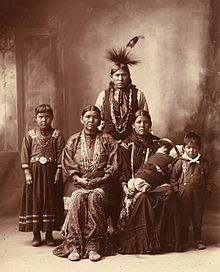

One of the primary functions of the family involves providing a framework for the production and reproduction of persons, biologically and/or socially. This can occur through the sharing of material substances (such as food); the giving and receiving of care and nurture (nurture kinship); jural rights and obligations; and moral and sentimental ties.[2][3] Thus, one's experience of one's family shifts over time. From the perspective of children, the family is a "family of orientation": the family serves to locate children socially and plays a major role in their enculturation and socialization.[4] From the point of view of the parent(s), the family is a "family of procreation," the goal of which is to produce and enculturate and socialize children.[5] However, producing children is not the only function of the family; in societies with a sexual division of labor, marriage, and the resulting relationship between two people, it is necessary for the formation of an economically productive household.[6][7][8]
Christopher Harris notes that the western conception of family is ambiguous, and confused with the household, as revealed in the different contexts in which the word is used:
"We have seen that people can refer to their relatives as 'the family.' 'All the family turned up for the funeral.... But of course, my brother didn't bring his family along - they're much too young.' Here the reference is to the offspring (as distinct from 'all' the family). The neighbors were very good, too. 'The Jones came, and their two children. It was nice, the whole family turning up like that.' Here the usage is more restricted than 'relatives' or 'his relatives,' but includes just both parents and offspring. 'Of course, the children will be leaving home soon. It's always sad to see the family break up like that.' Here the reference is not only to parents and children but to their co-residence, that is, to the household."[9]
Olivia Harris states this confusion is not accidental, but indicative of the familial ideology of capitalist, western countries that pass social legislation that insists members of a nuclear family should live together, and that those not so related should not live together; despite the ideological and legal pressures, a large percentage of families do not conform to the ideal nuclear family type.[10]
Types

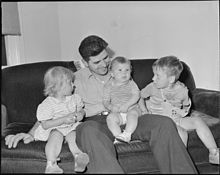
The diverse data coming from ethnography, history, law and social statistics, establish that the human family is an institution and not a biological fact found on the natural relationship of consanguinity.[11][12] The different types of families occur in a wide variety of settings, and their specific functions and meanings depend largely on their relationship to other social institutions. Although the concept of consanguinity originally referred to relations by "blood," cultural anthropologists have argued that one must understand the idea of "blood" metaphorically and that many societies understand family through other concepts rather than through genetic distance.[2] Sociologists have a special interest in the function and status of these forms in stratified (especially capitalist) societies. However, in societies with the presence of extended families, their basis is more structured in the reality of actual relatedness rather than on even afinityor anything else entirely. Herbert Gintis, economist and evolutionary scholar, in his response to the book Sex at Dawn, critiques the idea that human males were unconcerned with parentage, "which would make us unlike any other species I can think of".[13]
According to the work of scholars Max Weber, Alan Macfarlane, Steven Ozment, Jack Goody and Peter Laslett, the huge transformation that led to modern marriage in Western democracies was "fueled by the religio-cultural value system provided by elements of Judaism, early Christianity, Roman Catholic canon law and the Protestant Reformation".[14]
Much sociological, historical and anthropological research dedicates itself to the understanding of this variation, and of changes in the family that form over time. "Times have changed; it is more acceptable and encouraged for mothers to work and fathers to spend more time at home with the children. The way roles are balanced between the parents will help children grow and learn valuable life lessons. There is great importance of communication and equality in families, in order to avoid role strain."[15]
Conjugal (nuclear or single) family
The term "nuclear family" is commonly used, especially in the United States, to refer to conjugal families. A "conjugal" family includes only the husband, the wife, and unmarried children who are not of age.[16] Sociologists distinguish between conjugal families (relatively independent of the kindred of the parents and of other families in general) and nuclear families (which maintain relatively close ties with their kindred). However, in the 21st century, the "nuclear family", according to the 2010 Census, is "disappearing at a rapid rate are homes with "traditional" nuclear families—Mom, Dad and two children."[17] The nuclear family is being replaced by other family structures such as blended parents, single parents, and domestic partnerships.
Matrifocal family
A "matrifocal" family consists of a mother and her children. Generally, these children are her biological offspring, although adoption of children is a practice in nearly every society. This kind of family is common where women have the resources to rear their children by themselves, or where men are more mobile than women. As a definition, "a family or domestic group is matrifocal when it is centred on a woman and her children. In this case the father(s) of these children are intermittently present in the life of the group and occupy a secondary place. The children's mother is not necessarily the wife of one of the children's fathers."[18]
Extended family
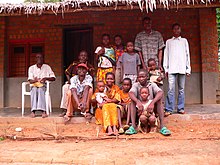
The term "extended family" is also common, especially in United States. This term has two distinct meanings. First, it serves as a synonym of "consanguinal family" (consanguine means "of the same blood"). Second, in societies dominated by the conjugal family, it refers to "kindred" (an egocentric network of relatives that extends beyond the domestic group) who do not belong to the conjugal family. These types refer to ideal or normative structures found in particular societies. Any society will exhibit some variation in the actual composition and conception of families.
Blended family
The term blended family or stepfamily describes families with mixed parents: one or both parents remarried, bringing children of the former family into the new family.[19] Also in sociology, particularly in the works of social psychologist Michael Lamb,[20] traditional family refers to "a middleclass family with a bread-winning father and a stay-at-home mother, married to each other and raising their biological children," and nontraditional to exceptions from this rule. Most of the US households are now non-traditional under this definition.[21]
In terms of communication patterns in families, there are a certain set of beliefs within the family that reflect how its members should communicate and interact. These family communication patterns arise from two underlying sets of beliefs. One being conversation orientation (the degree to which the importance of communication is valued) and two, conformity orientation (the degree to which families should emphasize similarities or differences regarding attitudes, beliefs, and values).[22]
Monogamous family
A monogamous family is based on legal or social monogamy. In this case, an individual has only one (official) partner during their lifetime or at any one time (i.e. serial monogamy).[23] This means that a person may not have several different legal spouses at the same time, as this is usually prohibited by bigamy laws, in jurisdictions that require monogamous marriages.
Polygamous family
Polygamy is a marriage that includes more than two partners.[24][25] When a man is married to more than one wife at a time, the relationship is called polygyny; and when a woman is married to more than one husband at a time, it is called polyandry. If a marriage includes multiple husbands and wives, it can be called polyamory,[26] group or conjoint marriage.[25]
Polygyny
Polygyny is a form of plural marriage, in which a man is allowed more than one wife .[27] In modern countries that permit polygamy, polygyny is typically the only form permitted. Polygyny is practiced primarily (but not only) in parts of the Middle East and Africa; and is often associated with Islam.
Polyandry
Polyandry is a form of marriage whereby a woman takes two or more husbands at the same time.[28] Fraternal polyandry, where two or more brothers are married to the same wife, is a common form of polyandry. Polyandry was traditionally practiced in areas of the Himalayan mountains, among Tibetans in Nepal, in parts of China and in parts of northern India. Polyandry is most common in societies marked by high male mortality or male absenteeism.[28]
Kinship terminology
Degrees of kinship
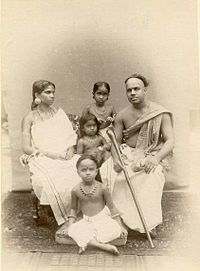

A first-degree relative is one who shares 50% of your DNA, such as a full sibling, parent or progeny.
| Kinship | Degree of relationship |
Genetic overlap |
|---|---|---|
| Inbred Strain | not applicable | 99% |
| Identical twins | not applicable | 100%[29] |
| Full sibling | first-degree | 50% (2−2+2−2) |
| Parent-offspring[30] | first-degree | 50% (2−1) |
| Offspring/progeny | first-degree | 50% (2−1) |
| Half-sibling | second-degree | 25% (2−2) |
| 3/4 siblings or sibling-cousin | second-degree | 37.5% (2−2+2⋅2−4) |
| Grandmother/grandfather | second-degree | 25% (2−2) |
| Niece/nephew | third-degree | 25% (2⋅2−3) |
| Aunt/uncle | third-degree | 25% (2⋅2−3) |
| Half-aunt, half-uncle | third-degree | 12.5% (2⋅2−4) |
| Half-niece/half-nephew | third-degree | 12.5% (2⋅2−4) |
| Great grandparent | third-degree | 12.5% (2−3) |
| First cousin | fourth-degree | 12.5% (2⋅2−4) |
| Double first cousin | fourth-degree | 25% (2−3+2−3) |
| Half-first cousin | fourth-degree | 6.25% (2−4) |
| First cousin once removed | fifth-degree | 6.25% (2⋅2−5) |
| Second cousin | sixth-degree | 3.125% 3.13% (2−6+2−6) |
| Double second cousin | sixth-degree | 6.25% (4⋅2−6) |
| Triple second cousin | sixth-degree | 12.5% (8⋅2−6) |
| Quadruple second cousin | sixth-degree | 9.38% (6⋅2−6) |
| Third cousin | seventh-degree | 0.781% (2⋅2−8) |
| Fourth cousin | tenth-degree | 0.20% (2⋅2−10)[31] |
Terminologies

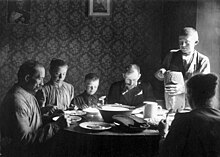
In his book Systems of Consanguinity and Affinity of the Human Family, anthropologist Lewis Henry Morgan (1818–1881) performed the first survey of kinship terminologies in use around the world. Although much of his work is now considered dated, he argued that kinship terminologies reflect different sets of distinctions. For example, most kinship terminologies distinguish between sexes (the difference between a brother and a sister) and between generations (the difference between a child and a parent). Moreover, he argued, kinship terminologies distinguish between relatives by blood and marriage (although recently some anthropologists have argued that many societies define kinship in terms other than "blood").
Morgan made a distinction between kinship systems that use classificatory terminology and those that use descriptive terminology. Classificatory systems are generally and erroneously understood to be those that "class together" with a single term relatives who actually do not have the same type of relationship to ego. (What defines "same type of relationship" under such definitions seems to be genealogical relationship. This is problematic given that any genealogical description, no matter how standardized, employs words originating in a folk understanding of kinship.) What Morgan's terminology actually differentiates are those (classificatory) kinship systems that do not distinguish lineal and collateral relationships and those (descriptive) kinship systems that do. Morgan, a lawyer, came to make this distinction in an effort to understand Seneca inheritance practices. A Seneca man's effects were inherited by his sisters' children rather than by his own children.[32] Morgan identified six basic patterns of kinship terminologies:
- Hawaiian: only distinguishes relatives based upon sex and generation.
- Sudanese: no two relatives share the same term.
- Eskimo: in addition to distinguishing relatives based upon sex and generation, also distinguishes between lineal relatives and collateral relatives.
- Iroquois: in addition to sex and generation, also distinguishes between siblings of opposite sexes in the parental generation.
- Crow: a matrilineal system with some features of an Iroquois system, but with a "skewing" feature in which generation is "frozen" for some relatives.
- Omaha: like a Crow system but patrilineal.
Roles
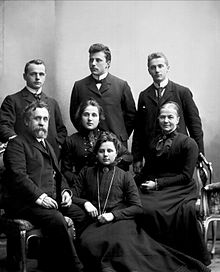
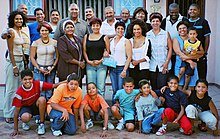

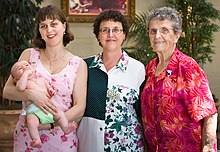
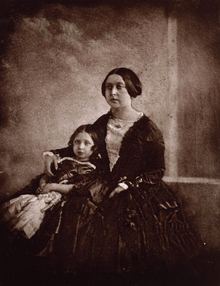
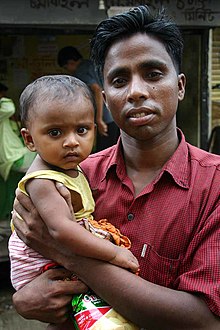
Most Western societies employ Eskimo kinship terminology.[citation needed] This kinship terminology commonly occurs in societies based on conjugal (or nuclear) families, where nuclear families have a degree of relative mobility. Members of the nuclear use descriptive kinship terms:
- Father: a male parent
- Mother: a female parent
- Son: a male child of the parent(s)
- Daughter: a female child of the parent(s)
- Brother: a male sibling
- Sister: a female sibling
- Grandfather: the father of a parent
- Grandmother: the mother of a parent
- Cousins: two people who share at least one grandparent in common, but neither the same parents.
Such systems generally assume that the mother's husband is also the biological father. In some families, a woman may have children with more than one man or a man may have children with more than one woman. The system refers to a child who shares only one parent with another child as a "half-brother" or "half-sister". For children who do not share biological or adoptive parents in common, English-speakers use the term "stepbrother" or "stepsister" to refer to their new relationship with each other when one of their biological parents marries one of the other child's biological parents. Any person (other than the biological parent of a child) who marries the parent of that child becomes the "stepparent" of the child, either the "stepmother" or "stepfather". The same terms generally apply to children adopted into a family as to children born into the family. In the United States, one in five mothers have children by different fathers; among mothers with two or more children the figure is higher, with 28% having children with at least two different men. Such families are more common among Blacks and Hispanics, and among the lower socioeconomic class.[33]
Typically, societies with conjugal families also favor neolocal residence; thus upon marriage a person separates from the nuclear family of their childhood (family of orientation) and forms a new nuclear family (family of procreation). However, in western society the single parent family has been growing more accepted and has begun to make an impact on culture. Single parent families are more commonly single mother families than single father. These families sometimes face difficult issues besides the fact that they have to rear their children on their own, for example low income making it difficult to pay for rent, child care, and other necessities for a healthy and safe home. Members of the nuclear families of members of one's own (former) nuclear family may class as lineal or as collateral. Kin who regard them as lineal refer to them in terms that build on the terms used within the nuclear family:
- Grandparent
- Grandfather: a parent's father
- Grandmother: a parent's mother
- Grandchild
- Grandson: a child's son
- Granddaughter: a child's daughter
For collateral relatives, more classificatory terms come into play, terms that do not build on the terms used within the nuclear family:
- Uncle: father's brother, mother's brother, father's sister's husband, mother's sister's husband
- Aunt: father's sister, mother's sister, father's brother's wife, mother's brother's wife
- Nephew: brother's son, sister's son, husband's brother's son, husband's sister's son, wife's brother's son, wife's sister's son
- Niece: brother's daughter, sister's daughter, husband's brother's daughter, husband's sister's daughter, wife's brother's daughter, wife's sister's daughter
When additional generations intervene (in other words, when one's collateral relatives belong to the same generation as one's grandparents or grandchildren), the prefixes "great-" or "grand-" modifies these terms. Also, as with grandparents and grandchildren, as more generations intervene the prefix becomes "great-grand-," adding another "great-" for each additional generation. Most collateral relatives have never had membership of the nuclear family of the members of one's own nuclear family.
- Cousin: the most classificatory term; the children of uncles or aunts. One can further distinguish cousins by degrees of collaterality and by generation. Two persons of the same generation who share a grandparent count as "first cousins" (one degree of collaterality); if they share a great-grandparent they count as "second cousins" (two degrees of collaterality) and so on. If two persons share an ancestor, one as a grandchild and the other as a great-grandchild of that individual, then the two descendants class as "first cousins once removed" (removed by one generation); if they shared ancestor figures as the grandparent of one individual and the great-great-grandparent of the other, the individuals class as "first cousins twice removed" (removed by two generations), and so on. Similarly, if they shared ancestor figures as the great-grandparent of one person and the great-great-grandparent of the other, the individuals class as "second cousins once removed". Hence one can refer to a "third cousin once removed upwards."
Cousins of an older generation (in other words, one's parents' first cousins), although technically first cousins once removed, are often classified with "aunts" and "uncles." Similarly, a person may refer to close friends of one's parents as "aunt" or "uncle," or may refer to close friends as "brother" or "sister," using the practice of fictive kinship. English-speakers mark relationships by marriage (except for wife/husband) with the tag "-in-law." The mother and father of one's spouse become one's mother-in-law and father-in-law; the female spouse of one's child becomes one's daughter-in-law and the male spouse of one's child becomes one's son-in-law. The term "sister-in-law" refers to three essentially different relationships, either the wife of one's sibling, or the sister of one's spouse, or, in some uses, the wife of one's spouse's sibling. "Brother-in-law" expresses a similar ambiguity. The terms "half-brother" and "half-sister" indicate siblings who share only one biological or adoptive parent.
Types of kinship
Patrilineal
Patrilineality, also known as the male line or agnatic kinship, is a form of kinship system in which an individual's family membership derives from and is traced through his or her father's lineage.[34] It generally involves the inheritance of property, rights, names, or titles by persons related through male kin.
A patriline ("father line") is a person's father, and additional ancestors, as traced only through males. One's patriline is thus a record of descent from a man in which the individuals in all intervening generations are male. In cultural anthropology, a patrilineage is a consanguineal male and female kinship group, each of whose members is descended from the common ancestor through male forebears.
Matrilineal
Matrilineality is a form of kinship system in which an individual's family membership derives from and is traced through his or her mother's lineage. It may also correlate with a societal system in which each person is identified with their matriline – their mother's lineage – and which can involve the inheritance of property and/or titles. A matriline is a line of descent from a female ancestor to a descendant in which the individuals in all intervening generations are mothers – in other words, a "mother line". In a matrilineal descent system, an individual is considered to belong to the same descent group as her or his mother. This matrilineal descent pattern is in contrast to the more common pattern of patrilineal descent pattern.
Bilateral descent
Bilateral descent is a form of kinship system in which an individual's family membership derives from and is traced through both the paternal and maternal sides. The relatives on the mother's side and father's side are equally important for emotional ties or for transfer of property or wealth. It is a family arrangement where descent and inheritance are passed equally through both parents.[35] Families who use this system trace descent through both parents simultaneously and recognize multiple ancestors, but unlike with cognatic descent it is not used to form descent groups.[36]
Traditionally, this is found among some groups in West Africa, India, Australia, Indonesia, Melanesia, Malaysia and Polynesia. Anthropologists believe that a tribal structure based on bilateral descent helps members live in extreme environments because it allows individuals to rely on two sets of families dispersed over a wide area.[37]
History of theories
Social Darwinists
Early scholars of family history applied Darwin's biological theory of evolution in their theory of evolution of family systems.[38] American anthropologist Lewis H. Morgan published Ancient Society in 1877 based on his theory of the three stages of human progress from Savagery through Barbarism to Civilization.[39] Morgan's book was the "inspiration for Friedrich Engels' book" The Origin of the Family, Private Property and the State published in 1884.[40]
Engels expanded Morgan's hypothesis that economical factors caused the transformation of primitive community into a class-divided society.[41] Engels' theory of resource control, and later that of Karl Marx, was used to explain the cause and effect of change in family structure and function. The popularity of this theory was largely unmatched until the 1980s, when other sociological theories, most notably structural functionalism, gained acceptance.
The nuclear family in industrial society

Contemporary society generally views the family as a haven from the world, supplying absolute fulfillment. Zinn and Eitzen discuss the image of the "family as haven [...] a place of intimacy, love and trust where individuals may escape the competition of dehumanizing forces in modern society".[43] During industrialization, "[t]he family as a repository of warmth and tenderness (embodied by the mother) stands in opposition to the competitive and aggressive world of commerce (embodied by the father). The family's task was to protect against the outside world."[44] However, Zinn and Eitzen note, "The protective image of the family has waned in recent years as the ideals of family fulfillment have taken shape. Today, the family is more compensatory than protective. It supplies what is vitally needed but missing in other social arrangements."[45]
"The popular wisdom", according to Zinn and Eitzen, sees the family structures of the past as superior to those today, and families as more stable and happier at a time when they did not have to contend with problems such as illegitimate children and divorce. They respond to this, saying, "there is no golden age of the family gleaming at us in the far back historical past."[46] "Desertion by spouses, illegitimate children, and other conditions that are considered characteristics of modern times existed in the past as well."[47]
The postmodern family
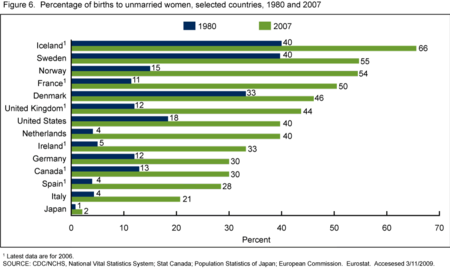
Others argue that whether or not one views the family as "declining" depends on one's definition of "family". "Married couples have dropped below half of all American households. This drop is shocking from traditional forms of the family system. Only a fifth of households were following traditional ways of having married couples raising a family together."[49] In the Western World, marriages are no longer arranged for economic, social or political gain, and children are no longer expected to contribute to family income. Instead, people choose mates based on love. This increased role of love indicates a societal shift toward favoring emotional fulfilment and relationships within a family, and this shift necessarily weakens the institution of the family.[50]
Margaret Mead considers the family as a main safeguard to continuing human progress. Observing, "Human beings have learned, laboriously, to be human", she adds: "we hold our present form of humanity on trust, [and] it is possible to lose it" ... "It is not without significance that the most successful large-scale abrogations of the family have occurred not among simple savages, living close to the subsistence edge, but among great nations and strong empires, the resources of which were ample, the populations huge, and the power almost unlimited"[51]
Many countries (particularly Western) have, in recent years, changed their family laws in order to accommodate diverse family models. For instance, in the United Kingdom, in Scotland, the Family Law (Scotland) Act 2006 provides cohabitants with some limited rights.[52] In 2010, Ireland enacted the Civil Partnership and Certain Rights and Obligations of Cohabitants Act 2010. There have also been moves at an international level, most notably, the Council of Europe European Convention on the Legal Status of Children Born out of Wedlock[53] which came into force in 1978. Countries which ratify it must ensure that children born outside marriage are provided with legal rights as stipulated in the text of this Convention. The Convention was ratified by the UK in 1981 and by Ireland in 1988.[54]
Oedipal family model and fascism
The model, common in the western societies, of the family triangle, husband-wife-children isolated from the outside, is also called the oedipal model of the family, and it is a form of patriarchal family. Many philosophers and psychiatrists have analyzed such a model. In such a family, they argue, the young develop in a perverse relationship, wherein they learn to love the same person who beats and oppresses them. They believe that young children grow up and develop loving a person who is oppressing them physically or mentally, and that these children are not taught in a way that will raise affectionate children.[55] Such philosophers claim that the family therefore constitutes the first cell of the fascist society, as the children will carry this attitude of love for oppressive figures in their adult life.[56][57] They claim that fathers torment their sons.[58][59] Deleuze and Guattari, in their analysis of the dynamics at work within a family, "track down all varieties of fascism, from the enormous ones that surround and crush us to the petty ones that constitute the tyrannical bitterness of our everyday lives".[56]
As it has been explained by Deleuze, Guattari and Foucault, as well as other philosophers and psychiatrists such as Laing and Reich, the patriarchal-family conceived in the West tradition serves the purpose of perpetuating a propertarian and authoritarian society.[60] The child grows according to the oedipal model, which is typical of the structure of capitalist societies,[11][12] and he becomes in turn owner of submissive children and protector of the woman.[59][61][62][63][64]
As the young undergoes physical and psychological repression from someone for whom they develop love, they develop a loving attitude towards authority figures. They will bring such attitude in their adult life, when they will desire social repression and will form docile subjects for society.[60] Michel Foucault, in his systematic study of sexuality, argued that rather than being merely repressed, the desires of the individual are efficiently mobilized and used,[56] to control the individual, alter interpersonal relationships and control the masses. Foucault believed organized religion, through moral prohibitions, and economic powers, through advertising, make use of unconscious sex drives. Dominating desire, they dominate individuals.[65] According to the analysis of Michel Foucault, in the west:
the [conjugal] family organization, precisely to the extent that it was insular and heteromorphous with respect to the other power mechanisms, was used to support the great "maneuvers" employed for the Malthusian control of the birthrate, for the populationist incitements, for the medicalization of sex and the psychiatrization of its nongenital forms.
— Michel Foucault, The History of Sexuality vol I, chap. IV, sect. Method, rule 3, p. 99
Domestic violence
Domestic violence (DV) is violence that happens within the family. The legal and social understanding of the concept of DV differs by culture. The definition of the term "domestic violence" varies, depending on the context in which it is used.[66] It may be defined differently in medical, legal, political or social contexts. The definitions have varied over time, and vary in different parts of the world.
The Convention on preventing and combating violence against women and domestic violence states that:[67]
- " “domestic violence” shall mean all acts of physical, sexual, psychological or economic violence that occur within the family or domestic unit or between former or current spouses or partners, whether or not the perpetrator shares or has shared the same residence with the victim".
In 1993, The United Nations Declaration on the Elimination of Violence against Women identified domestic violence as one of three contexts in which violence against women occurs, describing it as:[68]
- "Physical, sexual and psychological violence occurring in the family, including battering, sexual abuse of female children in the household, dowry-related violence, marital rape, female genital mutilation and other traditional practices harmful to women, non-spousal violence and violence related to exploitation".
Family violence
Family violence is a broader definition, often used to include child abuse, elder abuse, and other violent acts between family members.[69]
Child abuse is defined by the WHO as:[70]
- "Child maltreatment, sometimes referred to as child abuse and neglect, includes all forms of physical and emotional ill-treatment, sexual abuse, neglect, and exploitation that results in actual or potential harm to the child’s health, development or dignity. Within this broad definition, five subtypes can be distinguished – physical abuse; sexual abuse; neglect and negligent treatment; emotional abuse; and exploitation."
Elder abuse is, according to the WHO: "a single, or repeated act, or lack of appropriate action, occurring within any relationship where there is an expectation of trust which causes harm or distress to an older person".[71]
Parental abuse of children (child abuse)
Child abuse is the physical, sexual or emotional maltreatment or neglect of a child or children.[72] In the United States, the Centers for Disease Control and Prevention (CDC) and the Department for Children and Families (DCF) define child maltreatment as any act or series of acts of commission or omission by a parent or other caregiver that results in harm, potential for harm, or threat of harm to a child.[73] Child abuse can occur in a child's home, or in the organizations, schools or communities the child interacts with. There are four major categories of child abuse: neglect, physical abuse, psychological or emotional abuse, and sexual abuse.
Parental abuse by children
Abuse of parents by their children is a common but under reported and under researched subject. Parents are quite often subject to levels of childhood aggression in excess of normal childhood aggressive outbursts, typically in the form of verbal or physical abuse. Parents feel a sense of shame and humiliation to have that problem, so they rarely seek help and there is usually little or no help available anyway.[74][75]
Elder abuse
Elder abuse is "a single, or repeated act, or lack of appropriate action, occurring within any relationship where there is an expectation of trust, which causes harm or distress to an older person."[76] This definition has been adopted by the World Health Organization from a definition put forward by Action on Elder Abuse in the UK. Laws protecting the elderly from abuse are similar to, and related to, laws protecting dependent adults from abuse.
The core element to the harm of elder abuse is the "expectation of trust" of the older person toward their abuser. Thus, it includes harms by people the older person knows or with whom they have a relationship, such as a spouse, partner or family member, a friend or neighbor, or people that the older person relies on for services. Many forms of elder abuse are recognized as types of domestic violence or family violence.
Forced and child marriage
Forced and child marriages are practiced in certain regions of the world, particularly in Asia and Africa, and these types of marriages are associated with a high rate of domestic violence.[77][78][79][80]
A forced marriage is a marriage where one or both participants are married without their freely given consent.[81] The line between forced marriage and consensual marriage may become blurred, because the social norms of many cultures dictate that one should never oppose the desire of one's parents/relatives in regard to the choice of a spouse; in such cultures it is not necessary for violence, threats, intimidation etc. to occur, the person simply "consents" to the marriage even if he/she doesn't want it, out of the implied social pressure and duty. The customs of bride price and dowry, that exist in parts of the world, can lead to buying and selling people into marriage.[82][83]
A child marriage is a marriage where one or both spouses are under 18.[84][85] Child marriage was common throughout history but is today condemned by international human rights organizations.[86][87][88] Child marriages are often arranged between the families of the future bride and groom, sometimes as soon as the girl is born.[86] Child marriages can also occur in the context of marriage by abduction.[86]
The concept of family honor
Family honor is an abstract concept involving the perceived quality of worthiness and respectability that affects the social standing and the self-evaluation of a group of related people, both corporately and individually.[89][90] The family is viewed as the main source of honor and the community highly values the relationship between honor and the family.[91] The conduct of family members reflects upon family honor and the way the family perceives itself, and is perceived by others.[90] In cultures of honor maintaining the family honor is often perceived as more important than either individual freedom, or individual achievement.[92] In extreme cases, engaging in acts that are deemed to tarnish the honor of the family results in honor killings. An honor killing is the homicide of a member of a family or social group by other members, due to the perpetrators' belief that the victim has brought shame or dishonor upon the family or community, usually for reasons such as refusing to enter an arranged marriage, being in a relationship that is disapproved by their relatives, having sex outside marriage, becoming the victim of rape, dressing in ways which are deemed inappropriate, or engaging in homosexual relations.[93][94][95][96][97]
Economic issues
A family is often part of a sharing economy with common ownership.
Dowry, bride price and dower

Dowry is property (money, goods, or estate) that a wife or wife's family gives to her husband when the wife and husband marry.[98] Offering dowry was common in many cultures historically (including in Europe and North America), but this practice today is mostly restricted to some areas primarily in South Asia (India, Pakistan, Nepal, Bangladesh).
Bride price, (also bridewealth or bride token), is property paid by the groom or his family to the parents of a woman upon the marriage of their daughter to the groom. It is practiced mostly in Sub-Saharan Africa, parts of South-East Asia (Thailand, Cambodia), and parts of Central Asia.
Dower is property given to the bride herself by the groom at the time of marriage, and which remains under her ownership and control.[99]
Property regimes and taxation
In some countries married couples benefit from various taxation advantages not available to a single person or to unmarried couples. For example, spouses may be allowed to average their combined incomes. Some jurisdictions recognize common law marriage or de facto relations for this purposes. In some jurisdictions there is also an option of civil partnership or domestic partnership.
Different property regimes exist for spouses. In many countries, each marriage partner has the choice of keeping their property separate or combining properties. In the latter case, called community property, when the marriage ends by divorce each owns half. In lieu of a will or trust, property owned by the deceased generally is inherited by the surviving spouse.
Size
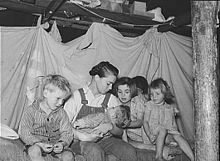
Natalism is the belief that human reproduction is the basis for individual existence, and therefore promotes having large families. Many religions, e.g., Islam, Christianity and Judaism,[100] encourage their followers to procreate and have many children, however many of them also propound stewardship and responsibility to care for the environment and society. In recent times, however, there has been an increasing amount of family planning and a following decrease in the total fertility rate in many parts of the world, in part due to improvements in health care, concerns of overpopulation, decreasing need for manual labor and increasing cost of raising a child as workers need to be more skilled. Many countries with population decline offer incentives for people to have large families as a means of national efforts to reverse declining populations.
Rights and laws
Reproductive rights
Reproductive rights are legal rights and freedoms relating to reproduction and reproductive health. These include the right to decide on issues regarding the number of children born, family planning, contraception, and private life, free from coercion and discrimination; as well as the right to access health services and adequate information.[101][102][103][104] According to UNFPA, reproductive rights "include the right to decide the number, timing and spacing of children, the right to voluntarily marry and establish a family, and the right to the highest attainable standard of health, among others".[105]
Mothers' rights
Mothers' rights movements focus on maternal health, workplace issues such as labor rights, breastfeeding, and rights in family law.
Fathers' rights
The fathers' rights movement is a movement whose members are primarily interested in issues related to family law, including child custody and child support, that affect fathers and their children.[106]
Children's rights
Children's rights are the human rights of children, with particular attention to the rights of special protection and care afforded to minors, including their right to association with both parents, their right to human identity, their right to be provided in regard to their other basic needs, and their right to be free from violence and abuse.[107][108][109]
Marriage rights
Each jurisdiction has its own marriage laws. These laws differ significantly from country to country; and these laws are often controversial. Areas of controversy include women's rights as well as same sex marriage.
Legal reforms
Legal reforms to family laws have taken place in many countries during the past few decades. These dealt primarily with gender equality within marriage and with divorce laws. Women have been given equal rights in marriage in many countries, reversing older family laws based on the dominant legal role of the husband. Coverture, which was enshrined in the common law of England and the US for several centuries and throughout most of the 19th century, was abolished. In some European countries the changes that lead to gender equality were slower: for example the requirement that married women must have their husbands’ permission to initiate judicial proceeding was abolished in Austria in 1975, in Spain in 1981, and in Switzerland in 1984.[110] In recent decades, the marital power has also been abolished in African countries that had this doctrine, but many African countries that were former French colonies still have discriminatory laws in their marriages regulations, such regulations originating in the Napoleonic Code that has inspired these laws.[110] In some countries (predominantly Roman Catholic) divorce was legalized only recently (e.g. Italy (1970), Portugal (1975), Brazil (1977), Spain (1981), Argentina (1987), Ireland (1996), Chile (2004) and Malta (2011)) although annulment and legal separation were options. Philippines still does not allow divorce. (see Divorce law by country). The laws pertaining to the situation of children born outside marriage have also been revised in many countries (see Legitimacy (law)).
Work-family balance
Work-family balance is a concept involving proper prioritizing between work/career and family life. It includes issues relating to the way how work and families intersect and influence each other. At a political level, it is reflected through policies such maternity leave and paternity leave. Since the 1950s, social scientists as well as feminists have increasingly criticized gendered arrangements of work and care, and the male breadwinner role, and policies are increasingly targeting men as fathers, as a tool of changing gender relations.[111]
Health
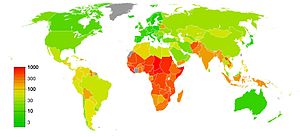
Family medicine
Family medicine is a medical specialty devoted to comprehensive health care for people of all ages; it is based on knowledge of the patient in the context of the family and the community, emphasizing disease prevention and health promotion.[113] The importance of family medicine is being increasingly recognized.[114]
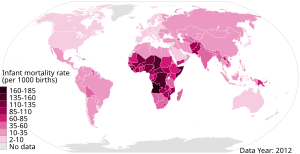
Maternal mortality
Maternal mortality or maternal death is defined by WHO as "the death of a woman while pregnant or within 42 days of termination of pregnancy, irrespective of the duration and site of the pregnancy, from any cause related to or aggravated by the pregnancy or its management but not from accidental or incidental causes."[116] Historically, maternal mortality was a major cause of women's death. In recent decades, advances in healthcare have resulted in rates of maternal mortality having dropped dramatically, especially in Western countries. Maternal mortality however remains a serious problem in many African and Asian counties.[116][117]
Infant and child mortality
Infant mortality is the death of a child less than one year of age. Child mortality is the death of a child before the child's fifth birthday. Like maternal mortality, infant and child mortality were common throughout history, but have decreased significantly in modern times.[118][119]
Politics
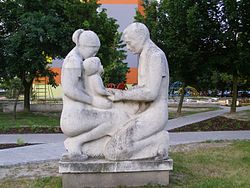
Family policies differ significantly between countries. Depending on jurisdiction, family policy may have a multiplicity of functions: horizontal redistribution, the enhancement of individual choices, increasing fertility rates, supporting economic growth and productivity, as well as reducing gender inequalities (Ferragina and Seeleib-Kaiser 2015).[120] From a societal perspective, family policies can contribute to "horizontal redistribution" between generations, as well as between households with and without children; to favour individual choices by supporting the reconciliation between care and paid work; and to reduce the costs of having children and child poverty. From an economic perspective, employment-oriented family policy is part of an overall redesign of welfare states geared to foster "active citizenship", also among mothers who were formerly not employed, through the development of an "enabling state". More generous family policies are said to lead to higher employment rates for women, mitigate the risk of unemployment for mothers after a substantial period of leave, support a social investment strategy, and offset some of the costs of raising children. From many feminist perspectives, family policies should aim at equalising opportunities between men and women through de-familialising care, encouraging men's involvement in care work, and facilitating employment opportunities for women. Profound social, economic, and cultural changes have led in many societies to the decline of the "male breadwinner model" and the move towards a variety of "adult worker models" (Daly 2011). Nevertheless, family policy expansion has not always fundamentally challenged gender inequalities: overall men have not increased their contribution to care work sufficiently to "compensate" for women's increased labour force participation and slightly reduced participation in care.
In an era of perceived permanent austerity and overall welfare state retrenchment, rich OECD countries have not been prevented from expanding family policies (Ferragina and Seeleib-Kaiser 2015).[120] In fact, in many of these countries there has been an expansion of family policies, leading to a socialisation of family care responsibilities, traditionally disproportionately performed by women (Daly and Lewis 2000). Although at the institutional policy level, the expansion of family policy might be characterised as a "silent revolution", relevant for gender equality, a cautious interpretation might be necessary: gender inequalities in income, opportunities, leisure and other significant outcomes remain and are sometimes sustained by policy, even if there is an observed shift in their character towards support for women's employment (Ferragina and Seeleib-Kaiser 2015).
The policy shift has been particularly significant in countries that had previously emphasised more conservative approaches to family policies, such as Germany, Ireland, Japan, and Norway. Hence, it can no longer be assumed that in the majority of rich OECD countries care for young children will be mainly provided through unpaid work within the family. Nevertheless, a certain number of countries still fail to provide adequate childcare arrangements, constituting a barrier for full-time maternal employment. Furthermore, in some countries, such as the United States and the United Kingdom, gender discrimination continues to strongly intersect with class; high childcare costs constitute a disincentive to labour force participation, especially among less educated and unskilled women (Esping-Andersen 2009). This means that higher-class and more educated women tend to have better opportunities than women belonging to a lower social class.
Partisanship and women's political agency have been the main drivers for family policy change during the 1980s and 1990s in many countries. For the 2000s, however, the importance of these drivers has significantly declined. As societal preferences have undergone profound changes — to some extent driven by the activities of women's equality movements, as well as by the experience of women's employment — the policy preferences of voters have also changed. Electorates in western democracies increasingly want policies supporting "modern" family lifestyles which depend on women's employment (Ferragina and Seeleib-Kaiser 2015). As political parties react to these changed policy preferences, the traditional differences in family policy positions between political parties decline. The extent to which this translates into support for gender equality, and how such equality might be defined, is as yet not decided. However, societal policy preferences, long believed to be set in stone, are undergoing profound changes; and public opinion increasingly matters for changing policies. The changed policy preferences are also mirrored in new political discourses that prioritise social investment and the preservation of the human capital of women, especially of those who are highly skilled. The expansion of family policies geared to supporting women's employment and investment in children is very likely to continue in western democracies.(Ferragina and Seeleib-Kaiser 2015).[120]
While in many parts of the world family policies seek to promote a gender-equal organization of the family life, in others the male-dominated family continues to be the official policy of the authorities, which is also supported by law. For instance, the Civil Code of Iran states at Article 1105: "In relations between husband and wife; the position of the head of the family is the exclusive right of the husband".[121]
In some parts of the world, some governments promote a specific form of family, such as that based on traditional family values. The term 'family values' is often used in political discourse in some countries, its general meaning being that of traditional or cultural values that pertain to the family's structure, function, roles, beliefs, attitudes, and ideals, usually involving the "traditional family" - a middle-class family with a breadwinner father and a homemaker mother, raising their biological children. Any deviation from this family model is considered a "nontraditional family".[122] These family ideals are often advanced through policies such as marriage promotion. Some jurisdictions outlaw practices which they deem as socially or religiously unacceptable, such as fornication, cohabitation or adultery.
Protection of private and family life
Article 8 of the European Convention on Human Rights provides a right to respect for one's "private and family life, his home and his correspondence", subject to certain restrictions that are "in accordance with law" and "necessary in a democratic society".[123]
Article 8 – Right to respect for private and family life
1. Everyone has the right to respect for his private and family life, his home and his correspondence.
2. There shall be no interference by a public authority with the exercise of this right except such as is in accordance with the law and is necessary in a democratic society in the interests of national security, public safety or the economic well-being of the country, for the prevention of disorder or crime, for the protection of health or morals, or for the protection of the rights and freedoms of others.
Criticism
Certain social scientists have advocated the abolition of the family. An early opponent of the family was Socrates whose position was outlined by Plato in The Republic.[124] In Book 5 of The Republic, Socrates tells his interlocutors that a just city is one in which citizens have no family ties.[125][126]
The family being such a deep-rooted and much-venerated institution, few intellectuals have ventured to speak against it. Familialism has been atypically defined as a “social structure where … a family's values are held in higher esteem than the values of the individual members of the family.”[127] Favoritism granted to relatives regardless of merit is called nepotism.
The Russian-American rationalist and individualist philosopher, novelist and playwright Ayn Rand compared partiality towards consanguinity with racism, as a small-scale manifestation of the latter.[128] “The worship of the family is merely racism, like a crudely primitive first installment on the worship of the tribe. It places the accident of birth above a man's values and duty to the tribe above a man's right to his own life.”[129] Additionally, she spoke in favor of childfree lifestyle, while following it herself.[128]
The British social critic, poet, mountaineer and occultist Aleister Crowley censured the institution of family in his works: “Horrid word, family! Its very etymology accuses it of servility and stagnation. / Latin, famulus, a servant; Oscan, Faamat, he dwells. … [T]hink what horrid images it evokes from the mind. Not only Victorian; wherever the family has been strong, it has always been an engine of tyranny. Weak members or weak neighbours: it is the mob spirit crushing genius, or overwhelming opposition by brute arithmetic. … In every Magical, or similar system, it is invariably the first condition which the Aspirant must fulfill: he must once and for all and for ever put his family outside his magical circle.”[130]
The American journalist Marty Nemko considers family to be overrated. “Politicians, clerics, and just plain folks extol family as our most important institution. / I believe family is overrated. So many people suffer inordinately from family. … / Millions of people don't even speak with a family member. Millions more spend years and fortunes on therapists, trying to undo the ills that family perpetrated on them. / All this shouldn’t be surprising. After all, unlike with friends, we are placed in our family of origin at random, with no say in the matter.”[131]
The family and social justice
One of the controversies regarding the family is the application of the concept of social justice to the private sphere of family relations, in particular with regard to the rights of women and children. Throughout much of the history, most philosophers who advocated for social justice focused on the public political arena, not on the family structures; with the family often being seen as a separate entity which needed to be protected from outside state intrusion. One notable exception was John Stuart Mill, who, in his work The Subjection of Women, advocated for greater rights for women within marriage and family.[132] Second wave feminists argued that the personal is political, stating that there are strong connections between personal experiences and the larger social and political structures. In the context of the feminist movement of the 1960s and 1970s, this was a challenge to the nuclear family and family values, as they were understood then.[133] Feminists focused on domestic violence, arguing that the reluctance - in law or in practice - of the state to intervene and offer protection to women who have been abused within the family, is in violation of women's human rights, and is the result of an ideology which places family relations outside the conceptual framework of human rights.[134]
See also
Notes and references
- ^ [...] from Latin familia 'family servants, domestics collectively, the servants in a household,' thus also 'members of a household, the estate, property; the household, including relatives and servants,' abstract noun formed from famulus 'servant, slave [...]' . Harper, Douglas. "family". Online Etymology Dictionary. Retrieved 2015-10-24.
- ^ a b Schneider, David 1984 A Critique of the Study of Kinship. Ann Arbor: University of Michigan Press. p. 182
- ^ Deleuze-Guattari (1972). Part 2, ch. 3, p. 80
- ^ Russon, John, (2003) Human Experience: Philosophy, Neurosis, and the Elements of Everyday Life, Albany: State University of New York Press. pp. 61–68.
- ^ George Peter Murdoch Social Structure p. 13
- ^ Wolf, Eric. 1982 Europe and the People Without History. Berkeley: University of California Press. 92
- ^ Harner, Michael 1975 "Scarcity, the Factors of Production, and Social Evolution," in Population, Ecology, and Social Evolution, Steven Polgar, ed. Mouton Publishers: the Hague.
- ^ Rivière, Peter 1987 "Of Women, Men, and Manioc", Etnologiska Studier (38).
- ^ Harris, Christopher (1983). The Family and Industrial Society. London: George Allen Unwin. p. 30.
- ^
Olivia Harris. Kate Young, Carol Wolkowitz, and Roslyn McCullagh (ed.). Of Marriage and the Market: Women's Subordination Internationally and its Lessons. London: Routeledge. p. 138.
{{cite book}}: CS1 maint: multiple names: editors list (link) - ^ a b Lacan 1938–2001, pp. 24–25, 56
- ^ a b Fugier Pascal, 2007, p.226-8
- ^ Gintis, Herbert. "Much that is True, but Remember: Is does not Imply Ought,". Amazon.com. Retrieved 10 October 2015.
- ^ "The Collapse of Marriage by Don Browning – The Christian Century". Religion-online.org. February 7, 2006. pp. 24–28. Retrieved 2007-07-10.
- ^ Levitan, Sara (2010). "Working wives and mothers: what happens to family life?" (PDF). Retrieved January 8, 2014.
- ^ Oregonstate.edu, Nuclear family – "A family group consisting of wife, husband (or one of these) and dependent children." – Definitions of Anthropological Terms – Anthropological Resources – (Court Smith) Department of Anthropology, Oregon State University
- ^ Caruso, Debra; Timmermann, Sandra (January 25, 2013). "The Disappearing Nuclear Family And The Shift To Non-Traditional Households Has Serious Financial Implications For Growing Numbers Of Americans". Huffington Post The Blog. Retrieved 4 November 2014.
- ^ Godelier, Maurice, trans. Nora Scott, The Metamorphoses of Kinship (London: Verso, 2011 (ISBN 978-1-84467-746-7)), p. 568 (Glossary, entry matrifocal) (trans. from Métamorphoses de la parenté (Librarie Arthème Fayard (apparently), 2004)) (author prof. anthropology, École des hautes études en sciences sociales, Paris).
- ^ Blended and Blessed – Encouraging Step-Families, blendedandblessed.com
- ^ "Department of Social and Developmental Psychology: PPSIS Faculty, Academic Profile". Sdp.cam.ac.uk. Retrieved 2011-03-26.
- ^ Civil Action No. 1:09-cv-10309 paragraph 17
- ^ McCornack, Steven (2010). Reflect & Relate an introduction to interpersonal communication. Boston/NY: Bedford/St. Martin's. pp. 369–370.
- ^ Cf. "Monogamy" in Britannica World Language Dictionary, R.C. Preble (ed.), Oxford-London 1962, p. 1275:1. The practice or principle of marrying only once. opp. to digamy now rare 2. The condition, rule or custom of being married to only one person at a time (opp. to polygamy or bigamy) 1708. 3. Zool. The habit of living in pairs, or having only one mate; The same text repeats The Shorter Oxford English Dictionary, W. Little, H.W. Fowler, J. Coulson (ed.), C.T. Onions (rev. & ed.,) Oxford 1969, 3rd edition, vol.1, p.1275; OED Online. March 2010. Oxford University Press. 23 Jun. 2010 Cf. Monogamy in Merriam-Webster Dictionary
- ^ http://www.scienceofrelationships.com/home/2012/8/17/opening-up-challenging-myths-about-consensual-non-monogamy.html
- ^ a b Zeitzen, Miriam Koktvedgaard (2008). Polygamy: a cross-cultural analysis. Berg. p. 3. ISBN 1-84520-220-1.
- ^ http://www.ejhs.org/volume6/polyamory.htm
- ^ Zeitzen, Miriam K. (2008). Polygamy: A Cross-Cultural Analysis. Oxford: Berg. p. 9.
- ^ a b Starkweather, Katherine; Raymond Hames (2012). "A Survey of Non-Classical Polyandry". 23 (2): 149–150.
{{cite journal}}: Cite journal requires|journal=(help) - ^ By replacement in the definition of the notion of "generation" by meiosis". Since identical twins are not separated by meiosis, there are no "generations" between them, hence n=0 and r=1. See genetic-genealogy.co.uk.
- ^ "Kin Selection". Benjamin/Cummings. Retrieved 2007-11-25.
- ^ This degree of relationship is usually indistinguishable from the relationship to a random individual within the same population (tribe, country, ethnic group).
- ^ Tooker, Elisabeth. "Another View of Morgan on Kinship." Current Anthropology 20, no. 1 (March 1979): 131–134.
- ^ http://www.nbcnews.com/id/42364656/ns/health-childrens_health/t/us-moms-have-kids-multiple-dads-study-says/#.VaJYA7XD_Ao
- ^ Benokraitis, N. V. Marriages and Families. 7th Edition, Pearson Education, Inc., 2011
- ^ Shepard, Jon; Greene, Robert W. (2003). Sociology and You. Ohio: Glencoe McGraw-Hill. pp. A–22. ISBN 0-07-828576-3.
- ^ Stone, Linda (2006). Kinship and Gender: An Introduction. Boulder, Colorado: Westview Press. pp. 168–169. ISBN 978-0-8133-4302-0.
- ^ Ezzell, Carol (June 2001). "The Himba and the Dam". Scientific American. 284 (6): 80–90. doi:10.1038/scientificamerican0601-80. PMID 11396346.
- ^ "Sociology/Founding the discipline". Encyclopædia Britannica. Retrieved 2009-07-26.
- ^ Morgan 1877
- ^ "Cultural Anthropology". Encyclopædia Britannica. Retrieved 2009-07-22.
- ^ "The Marxists Internet Archive". Retrieved 2009-07-17.
- ^ Williams, Brian; Stacey C. Sawyer; Carl M. Wahlstrom (2005). Marriages, Families & Intimate Relationships. Boston, MA: Pearson. 0-205-36674-0.
- ^
Zinn, Maxine Baca; D. Stanley Eitzen (2002). Diversity in families (6 ed.). Allyn and Bacon. p. 557. ISBN 978-0-205-33522-0. Retrieved 2012-01-06.
This 'family as haven' image of a refuge from an impersonal world characterizes the family as a place of intimacy, love, and trust in which individuals may escape the competition of dehumanizing forces in modern society. Christopher Lasch (1977:8) has named this image a 'haven in a heartless world' and described it as a glorification of private life made necessary by the deprivations experienced in the public world.
- ^ Zinn and Eitzen (1987) Diversity in American families, p. 3
- ^ Zinn and Eitzen (1987) Diversity in American families, p. 3
- ^ Zinn and Eitzen (1987) Diversity in American families, p. 8
- ^ Zinn and Eitzen (1987) Diversity in American families, p. 8
- ^ "Changing Patterns of Nonmarital Childbearing in the United States". CDC/National Center for Health Statistics. May 13, 2009. Retrieved September 24, 2011.
- ^ Tavernise, Sabrina (2011). "Married Couples Are No Longer a Majority, Census Finds". Retrieved January 8, 2014.
- ^ Coontz, Stephanie. 2005. Marriage, A History: How Love Conquered Marriage. New York: Viking/Penguin Books.
- ^ Male and Female, New York, 1949. pp. 193-194
- ^ http://www.scotland.gov.uk/Topics/Justice/law/17867/fm-couples-root/fm-couples-cohabitation
- ^ http://conventions.coe.int/Treaty/en/Treaties/Html/085.htm
- ^ http://conventions.coe.int/Treaty/Commun/ChercheSig.asp?NT=085&CM=&DF=&CL=ENG
- ^ "About Family". Word Press. 31 March 2012. Retrieved January 8, 2014.
- ^ a b c Foucault (1984) Preface to the American edition of Anti-Œdipus pp. xiii–xvi.
- ^ Wilhelm Reich (1933) The Mass Psychology of Fascism, Chapter V, The Sex-Economic Presuppositions of the Authoritarian Family
- ^ John Phillips Structural Linguistics and Anthropology, courses.nus.edu.sg
- ^ a b Wilhelm Reich [1936] The Sexual Revolution, Chapter V, The compulsive family as educational apparatus, pp. 71–77
- ^ a b Deleuze-Guattari (1972). Part 2, ch. 7, pp. 129–31
- ^ Gianni Vattimo. "Tutto in famiglia". Il Manifesto date=October 15, 2004 (in Italian). Archived from the original on 2007-10-11.
{{cite web}}: Missing pipe in:|work=(help) - ^ Template:It icon Luttazzi, Daniele Bollito misto con mostarda (2005) p. 262, books.google.com
- ^ Theodor W. Adorno and Stephen Crook Adorno ISBN 0-415-27099-5, p. 9-10, books.google.com
- ^ E. James Anthony, The Family and the Psychoanalytic Process in Children (1980). Psychoanalytic Study of the Child, 35:3–34, pep-web.org
- ^ Foucault, The History of Sexuality
- ^ Definitions of Domestic Violence
- ^ Council of Europe - Convention on preventing and combating violence against women and domestic violence (CETS No. 210)
- ^ http://www.un.org/documents/ga/res/48/a48r104.htm
- ^ Wallace, p. 2
- ^ http://www.who.int/topics/child_abuse/en/
- ^ http://www.who.int/ageing/projects/elder_abuse/en/
- ^ "Child abuse – definition of child abuse by the Free Online Dictionary, Thesaurus and Encyclopedia". Thefreedictionary.com. Retrieved 15 September 2010.
- ^ Leeb, R.T.; Paulozzi, L.J.; Melanson, C.; Simon, T.R.; Arias, I. (1 January 2008). "Child Maltreatment Surveillance: Uniform Definitions for Public Health and Recommended Data Elements". Centers for Disease Control and Prevention. Retrieved 20 October 2008.
- ^ Growing levels of concern from parents and carers experiencing aggression from their children
- ^ WHEN FAMILY LIFE HURTS: Family experience of aggression in children - Parentline plus 31 October 2010
- ^ elderabus.org.uk, accessed October 12, 2007.
- ^ Q & A: Child Marriage and Violations of Girls' Rights | Human Rights Watch
- ^ WHO | Child marriages: 39 000 every day
- ^ I have a right to | BBC World Service
- ^ End early and forced marriage - Because I am a Girl - Plan UK
- ^ http://www.bbc.co.uk/ethics/forcedmarriage/introduction_1.shtml
- ^ http://www.bbc.co.uk/ethics/slavery/modern/modern_1.shtml#section_2
- ^ http://www.ohchr.org/Documents/HRBodies/HRCouncil/RegularSession/Session21/A-HRC-21-41_en.pdf
- ^ http://www.unicef.org/protection/57929_58008.html
- ^ http://www.hrw.org/news/2013/06/14/q-child-marriage-and-violations-girls-rights
- ^ a b c "I have a right to - BBC World Service". Retrieved 7 October 2014.
- ^ http://www.girlup.org/assets/pdfs/factsheet1-about-child-marriage.pdf
- ^ "WHO - Child marriages: 39 000 every day". Retrieved 7 October 2014.
- ^ Bruce J. Malina (15 February 2001). The New Testament world: insights from cultural anthropology. Westminster John Knox Press. p. 42. ISBN 978-0-664-22295-6. Retrieved 7 November 2011.
- ^ a b Mosquera, Patricia M. R.; Antony S. R. Manstead; Agneta H. Fischer (January 2002). "Honor in the Mediterranean and Northern Europe". Journal of Cross-Cultural Psychology. 33 (1): 16–36. doi:10.1177/0022022102033001002. Retrieved 17 October 2011.
- ^ Berns, Roberta (2007). Child,family,school,community:socialization and support. Thompson Learning. p. 139. ISBN 0495007587.
- ^ Monica McGoldrick; Joseph Giordano; Nydia Garcia-Preto (18 August 2005). Ethnicity and family therapy. Guilford Press. p. 445. ISBN 978-1-59385-020-3. Retrieved 24 October 2011.
- ^ "Ethics: Honour Crimes". BBC. 1 January 1970. Retrieved 23 December 2013.
- ^ "Honor killing: Definition and More from the Free Merriam-Webster Dictionary". merriam-webster.com. 31 August 2012. Retrieved 23 December 2013.
- ^ "Honor killing definition". dictionary.reference.com. Retrieved 23 December 2013.
- ^ "Shocking gay honor killing inspires movie - CNN.com". Edition.cnn.com. Retrieved 16 August 2013.
- ^ "Iraqi immigrant convicted in Arizona 'honor killing' awaits sentence - CNN.com". Edition.cnn.com. 23 February 2011. Retrieved 16 August 2013.
- ^ http://www.merriam-webster.com/dictionary/dowry
- ^ Goody, Jack (1976). Production and Reproduction: A Comparative Study of the Domestic Domain. Cambridge: Cambridge University Press. p. 8.
- ^ Joys of A Large Family, by Rebbetzin Faige Twerski. angelfire.com
- ^ WHO | Gender and Reproductive Rights
- ^ UNFPA State of World Population 2005
- ^ WHO | Gender and human rights
- ^ Sexual and reproductive rights | Amnesty International
- ^ Reproductive Rights: Advancing Human Rights: UNFPA
- ^ Collier & Sheldon, 2006, p. 1–26.
- ^ .http://www.unicef.org/crc/index_protecting.html
- ^ Children's Rights
- ^ Children and human rights | Amnesty International
- ^ a b http://wbl.worldbank.org/~/media/FPDKM/WBL/Documents/Reports/2014/Women-Business-and-the-Law-2014-Key-Findings.pdf
- ^ Bjørnholt, M. (2014). "Changing men, changing times; fathers and sons from an experimental gender equality study" (PDF). The Sociological Review. 62 (2): 295–315. doi:10.1111/1467-954X.12156.
- ^ Country Comparison: Maternal Mortality Rate in The CIA World Factbook.
- ^ What is Family Medicine? | Department of Family Medicine
- ^ WHO | The rising importance of family medicine
- ^ Infant Mortality Rates in 2012, UNICEF, 2013.
- ^ a b WHO | Maternal mortality ratio (per 100 000 live births)
- ^ WHO | Maternal mortality
- ^ WHO | Infant mortality
- ^ WHO | Children: reducing mortality
- ^ a b c http://sp.oxfordjournals.org/content/22/1/1.full
- ^ http://www.alaviandassociates.com/documents/civilcode.pdf#
- ^ Panasenko, N (2013). "Czech and Slovak Family Patterns and Family Values in Historical, Social and Cultural Context". Journal of Comparative Family Studies. 44 (1): 79–98.
{{cite journal}}:|access-date=requires|url=(help) - ^ http://echr-online.com/art-8-echr/introduction
- ^ Abolition of the Family for the Guardians and the Use of War (457b-471c)
- ^ SparkNotes: The Republic: Book V
- ^ LitCharts | The Republic: Book 5 Summary, Analysis & Themes
- ^ “Your Dictionary (the Dictionary You Can Understand)”. Dictionary definitions. familialism.
- ^ a b Heller, Anne C. (2009). Ayn Rand and the World She Made. New York: Doubleday. pp. 320–321. ISBN 978-0-385-51399-9. OCLC 2290274371.
{{cite book}}: Invalid|ref=harv(help) Said in one of the lectures Ayn Rand delivered. - ^ Said in one of the public lectures Ayn Rand delivered
- ^ Crowley, Aleister. Magick Without Tears. Chapter LII “Family: Public Enemy No. 1”. Falcon Press, 1982. ISBN 0-941404-17-X
- ^ Nemko, Marty. "Family is Overrated. September 12, 2008
- ^ http://plato.stanford.edu/entries/feminism-family/
- ^ Angela Harutyunyan, Kathrin Hörschelmann, Malcolm Miles (2009) Public Spheres After Socialism pp.50-1
- ^ Domestic Violence A Violation of Human Rights of Women
Bibliography
- Daly, Mary (2011) What adult worker model? A critical look at recent social policy reform in Europe from a gender and family perspective. Social Politics,18(1):1-23.
- Daly, Mary and Lewis, Jane (2000). The concept of social care and the analysis of contemporary welfare states. British Journal of Sociology, 51(2):281-98.
- Esping-Andersen, Gøsta 2009). The incomplete revolution: Adapting welfare states to women's new roles. Cambridge: Polity Press.
- Chevallier, Denis. "Famille et parenté: une bibliographie". Terrain (in French). Retrieved January 8, 2014.
- Ferragina, Emanuele and Seeleib-Kaiser, Martin (2015) "Determinants of a Silent (R)evolution:Understanding the Expansion of Family Policy in Rich OECD Countries", Social politics 22 (1), 1-37.
- Forbes, Scott, A Natural History of Families, (Princeton, NJ: Princeton University Press, 2005), ISBN 0-691-09482-9
- Foucault, Michel (1978). The History of Sexuality: Volume I: An Introduction. (New York: Vintage Books). ISBN 978-0-679-72469-8
- Gilroy, Paul Identity Belonging and the Critique of Pure Sameness in Gilroy, Paul (2000) Against Race: Imagining Political Culture Beyond the Color Line, (Cambridge, Mass.: Belknap Press of Harvard University Press), Ch. I.3, pp. 97–133
- Goody, Jack The Development of the Family and Marriage in Europe (Cambridge University Press, 1980); translated into Spanish, French, Italian, Portuguese.
- Mock, Douglas W., More Than Kin and Less Than Kind, (Belknap Press, 2004), ISBN 0-674-01285-2
- Schneider, David M., American Kinship: a cultural approach (Chicago: University of Chicago Press, 1980).
- Tabak I., Mazur J., Granado M.C., Örkenyi Á., Zaborskis A., Aasvee K. & Moreno C. (2012). "Examining trends in parent-child communication in Europe over 12 years". The Journal of Early Adolescence. pp. 26–54. doi:10.1177/0272431611419509. Retrieved January 8, 2014.
{{cite web}}: CS1 maint: multiple names: authors list (link) - Ommer, Uwe. 1000 Families: das Familienalbum des Planeten Erde. Taschen, Cologne 2002, ISBN 3-8228-2264-7
External links
select an article title from: Wikisource:1911 Encyclopædia Britannica
- Family database, OECD,
- Family Research Laboratory, unh.edu
- "Family evolution and contemporary social transformations" (PDF). seres.fcs.ucr.ac.cr. Estación de Economía Política. Archived from the original (PDF) on 2008-10-29.
- Family Facts: Social Science Research on Family, Society & Religion (a Heritage Foundation site). familyfacts.org
- Families Australia – independent peak not-for-profit organisation. familiesaustralia.org.au
- FamilyPlatform – A consortium of 12 organisations providing input into the European Union's Socio-Economic and Humanities Research Agenda on Family Research and Family Policies.
- Unitedfamilies.org, International organisation
- UN.org, Families and Development
- Family, marriage and "de facto" unions, Vatican.va
Template:Articles of the Universal Declaration of Human Rights
